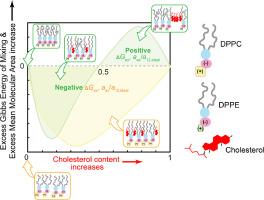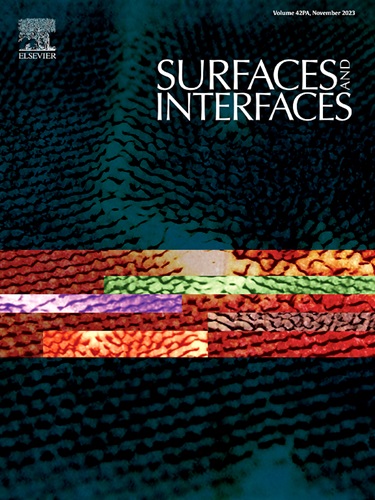齐聚物头基对磷脂和胆固醇二元混合物中单层形成和界面扩张流变的作用悬滴张力计研究
IF 5.7
2区 材料科学
Q2 CHEMISTRY, PHYSICAL
引用次数: 0
摘要
由于脂质在膜稳定性和生物过程中的作用已得到公认,由具有独特分子结构的各种脂质组成的生物膜的复杂成分已引起越来越多的关注。即使磷脂头基和脂肪酰基尾部发生微妙变化,也会对空气-水界面上单层脂质的形成和界面动力学产生深远影响。然而,人们对这些过程中与脂质化学结构直接相关的分子间作用力和相互作用的分子层面的理解还不够深入。为了更好地理解这些复杂的物理化学现象,我们使用了可精确控制脂质类型和组成的简化模型单层。在本研究中,我们首次采用悬滴张力计技术研究了含有不同量胆固醇(CHOL)的 1,2-二棕榈酰-sn-甘油-3-磷脂胆碱(DPPC)和 1,2-二棕榈酰-sn-甘油-3-磷脂乙醇胺(DPPE)单层的形成和界面流变学。这两种磷脂的 C16:0 乙酰基尾部相同,但头基不同,它们与 CHOL 和水分子的界面相互作用存在明显差异,从而影响了单层的形成和流变性。在没有 CHOL 的情况下,DPPE 单层的扩张模量通常低于 DPPC,这是由于头基团水合作用增强所致。然而,引入 CHOL 后,这一趋势发生逆转,DPPE-CHOL 单层比 DPPC-CHOL 更硬。对于 CHOL,我们观察到它对 DPPC 单层具有众所周知的缩合效应,而对于 DPPE 单层,根据 CHOL 用量的不同,缩合效应和膨胀效应都会出现。我们希望这项工作不仅能加深我们对脂质分子结构-组成-性质关系的基本理解,还能为理解更复杂的生物系统奠定坚实的基础。本文章由计算机程序翻译,如有差异,请以英文原文为准。

Role of zwitterionic lipid headgroups on monolayer formation and interfacial dilatational rheology in binary mixtures of phospholipids and cholesterol: A pendant drop tensiometer study
The complex composition of biological membranes, comprising a diverse array of lipids with unique moieties, has garnered increased attention due to the recognized roles of lipids in membrane stability and biological processes. Even subtle changes in phospholipid headgroups and fatty acyl tails profoundly affect the formation and interfacial dynamics of lipid monolayers at the air-water interface. However, the molecular-level understanding of their intermolecular forces and interactions during these processes, directly relating to the lipid chemical structures, is not well-explored. To better understand these complex physicochemical phenomena, simplified model monolayers with precise control over lipid types and compositions are utilized. In this study, we employ the pendant drop tensiometer technique to investigate the formation and interfacial rheology of 1,2-dipalmitoyl-sn-glycero-3-phosphocholine (DPPC) and 1,2-dipalmitoyl-sn-glycero-3-phosphoethanolamine (DPPE) monolayers, with varying amounts of cholesterol (CHOL) for the first time. These two phospholipids, with identical C16:0 acyl tails but different headgroups, exhibit marked differences in their interfacial interactions with CHOL and water molecules, consequently affecting monolayer formation and rheology. In the absence of CHOL, DPPE monolayers typically display a lower dilatational modulus than DPPC, attributed to increased headgroup hydration. However, introducing CHOL reverses this trend, resulting in stiffer DPPE-CHOL monolayers compared to DPPC-CHOL. With CHOL, we observe its well-known condensation effect on DPPC monolayers, yet for DPPE monolayers, both condensation and expansion effects are noted, contingent on CHOL amount. We anticipate this work will not only deepen our fundamental understanding of the structure-composition-property relationships in lipid molecules but also provide a robust foundation for comprehending more intricate biological systems.
求助全文
通过发布文献求助,成功后即可免费获取论文全文。
去求助
来源期刊

Surfaces and Interfaces
Chemistry-General Chemistry
CiteScore
8.50
自引率
6.50%
发文量
753
审稿时长
35 days
期刊介绍:
The aim of the journal is to provide a respectful outlet for ''sound science'' papers in all research areas on surfaces and interfaces. We define sound science papers as papers that describe new and well-executed research, but that do not necessarily provide brand new insights or are merely a description of research results.
Surfaces and Interfaces publishes research papers in all fields of surface science which may not always find the right home on first submission to our Elsevier sister journals (Applied Surface, Surface and Coatings Technology, Thin Solid Films)
 求助内容:
求助内容: 应助结果提醒方式:
应助结果提醒方式:


